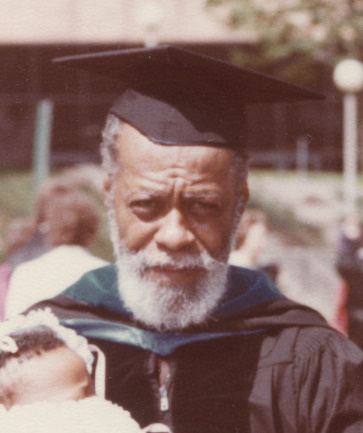
Soon after arriving at Kent State he became one of the key organizers of the first celebration of Black History Month in the U.S., which occurred in February 1970. It was six years later, during the U.S. bicentennial, that the expansion of Negro History Week, as it had been called, was recognized nationally when then President Gerald R. Ford delivered to the nation regarding the observance of Black History Month.
Significantly, the first celebration was a Pan-African affair which included the participation of cultural icons like Babatunde Olatunji and Pulitzer Prize winning poet Gwendolyn Brooks, as well as poets Eugene Redmond and Quincy Troupe. Dr. Donald Henderson, then director of the Experiment in Higher Education, lectured on the Black Aesthetic. That first celebration of Black History Month also included presentations by Jimmy Garrett and Chief Fela Sowande, both of whom were involved in the formation of new institutions that had a decidedly Black aesthetic and international impact. Jimmy Garrett was a key player in the formation of the first Black Student Union and subsequently the first Black studies department in the U.S., while Fela Sowande was aNigerian philosopher and musician of note who wrote Nigeria’s first national anthem. He spent the latter days of his career teaching Black Cosmology in the Department of Pan-African Studies atKent State University.
Due to the bare bones budgetary allocations for the Institute of African American Affairs by university officials and the need to implement an innovative curricular model, there was also a need to come up with a unique method for delivering lectures that would be extremely cost effective. During his tenure in East St. Louis Dr. Crosby had begun to use some innovative methods of curricular delivery, including, but not limited to videotaped lectures, the use of various types of films and a method of communal education dubbed “Each One Teach One.” All three of these methods were used at Kent facilitating the development of courses that could be taught by graduate assistants, who in many cases were later hired as full-time professors. This is how he developed a cadre of professors dedicated to Pan-African Studies. University officials had not foreseen this type of development of Black professors. Their original model incorporated professors from all over the campus, whose were dedicated to the philosophies and ideals of their individual departments; they would also have been hired, fired and paid by those departments. Because of this division of loyalty it would have been difficult, if not impossible to mold a conglomerate of professors from multiplicitous departments into a staff with a cohesive set of ideals or philosophical imperatives.
Other technological innovations include the first use of desktop computers in the main office of the Department of Pan-African Studies and one of the first computer labs for student use in an academic area unrelated to science or business classes.
Upon arriving at Kent there were a number of demands that students had placed on the table, including a Black Culture Center. This center was something university officials had never dreamed of, hence they have resisted the idea from the beginning and never gave any type of significant funding to the center to be able to promote Black culture on Kent’s campus.
The center went through a number of phases and was located in a number of buildings before finally ending up in the Old Student Union, now Oscar Ritchie Hall. Dr. Crosby visualized the center and the Institute as institutions that should work in tandem with each other. The Center of Pan-African Culture was established in 1970, through the combined efforts of Dr. Crosby, his staff and the leaders of the Black United Students at Kent State, providing a home for students to engage in cultural activities and a home for IAAA.
Today, the Center of Pan-African Culture still exists in a newly renovated Oscar Ritchie Hall, but the level of activities has seriously diminished, with the demise of the Pan-African Festival, last celebrated in 2007, the loss of much of the artwork that had graced the walls for the over 20 years and the relocation of the center of campus, Oscar Ritchie Hall is beginning to look more and more like a typical classroom building on any university campus.
